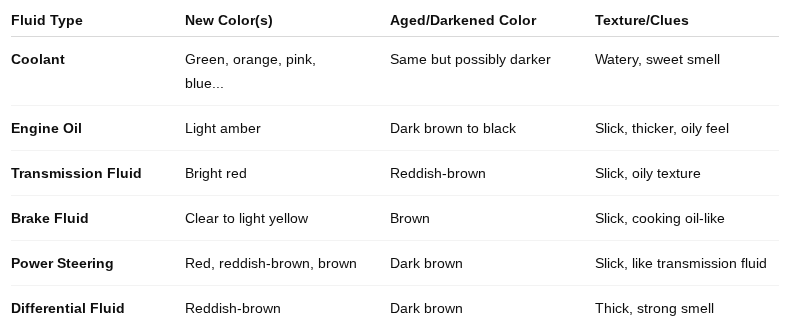Identifying Car Fluid Leak Colors: What They Mean for Your Vehicle
When you spot a puddle under your vehicle, it's instinctive to worry. But knowing how to identify car fluid leak colors can reveal a lot about what’s happening under the hood. This guide is a car leak color guide—a practical road map through the spectrum of common automotive fluids and what their colors mean for your car’s health and safety.
1. Identifying Coolant Leaks
💧 Typical Colors & Clues:
Coolant (antifreeze) comes in green, orange, yellow, pink, red, or blue-green, depending on manufacturer or type.
Where Leaks Emerge
Coolant typically leaks near the radiator, hoses, water pump, or engine gaskets
What It Means
Low coolant leads to overheating, risking engine damage. It’s toxic—especially to pets—so avoid contact. Even a small leak can escalate, so schedule repairs quickly.
2. Deciphering Oil Leak Colors
🛢️ Typical Colors & Consistency
Engine oil ranges from light brown (fresh) to dark brown/black with age. It’s thicker and slippery.
Where Leaks Emerge
Leaks appear under the oil pan, valve cover, around gaskets, seals, drain plug, or oil filter.
What It Means
Oil keeps your engine lubricated. A persistent oil leak may cause low oil levels, poor engine performance, or damage. Even minor drips warrant a check—especially if accompanied by burning smells or smoke.
3. Understanding Transmission Fluid Leaks
🔧 Typical Colors & Texture
Transmission fluid is usually bright red, which darkens to reddish-brown as it ages. It’s slick and oily.
Where Leaks Emerge
Look under the transmission pan, lines, seals, or near the front/middle chassis area.
What It Means
A leak may indicate failing seals, gaskets, or lines. If neglected, it can damage your transmission—causing rough shifts or slippage. Act fast: replacing a seal is far cheaper than a full rebuild.
4. Brake Fluid Leak Color Codes
🟡 Typical Colors & Feel
New brake fluid is clear to light yellow, darkening to brown over time. It feels oily and slick, often described as cooking-oil-like.
Where Leaks Emerge
Leaks appear near brake lines, calipers, master cylinder, or wheel cylinders.
What It Means
Brake fluid leaks are critical. Any puddle or spongy brake pedal means unsafe driving. Immediate professional attention is vital for your safety.
5. Power Steering Fluid Leaks
🔴 Typical Colors & Smell
Power steering fluid is often red, reddish-brown, or brown depending on age. Scented like petroleum.
Where Leaks Emerge
Common leak points include steering rack, hoses, pump, or sometimes shared lines with the transmission near the front of the vehicle.
What It Means
A loss of fluid leads to stiff steering, pump damage, or failing rack assembly. If the steering feels heavy or noisy, top up and have it inspected.
6. Spotting Differential Fluid Leaks
🛠️ Typical Colors & Smell
Differential fluid is a reddish-brown to dark brown, often thick and with a strong odor due to sulfur compounds.
Where Leaks Emerge
Leaks occur from the rear/front differential housing, axle seals, or vent lines.
What It Means
Low differential fluid can cause whining, noisy turns, or premature wear. Fixing axle seals or replacing housing gaskets before failure is best.
Quick Reference: Car Leak Color Guide

Pro Tips from the Field
- Always place cardboard under the leak, as Family Handyman's editor
Bob Lacivita notes, to capture color and location.
- Smell tests reveal coolant’s sweet scent vs. oil’s petroleum odor.
- Feel guides: brake fluid is silky and thin; oil/trans fluid more viscous.
- Age matters: fluids naturally darken. A brownish hue doesn’t always mean a big problem—check consistency and leak frequency.
Why Expert Eyes Matter
Our team brings decades of experience working across makes and models. We don't just spot the drip—we trace the source, recommend repair, and ensure your vehicle is safe and efficient. You get honest, transparent advice—and repairs done right the first time.
When to Act Fast
- Brake fluid leaks = 🚨 unsafe, drive no further.
- Gas leaks present fire hazards—call a tow.
- Transmission, coolant, power steering, differential fluid leaks may still drivable—but don’t wait. Persistent fluid loss leads to costly failures.
Final Thoughts
Understanding fluid colors in cars equips you to act with precision—not panic. Confidently spot common leaks, know the implications, and address issues before they escalate. Your safety, wallet, and vehicle longevity are all tied to this simple knowledge. When you need a closer inspection or repair from Athens Country Club to Showtime Bowling, we are ready with honest expertise and a personal touch.
Stay vigilant, stay safe, and keep your car performing at its best!
